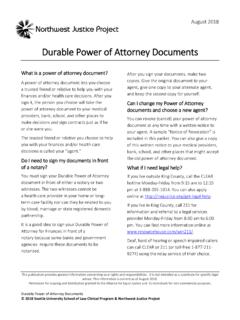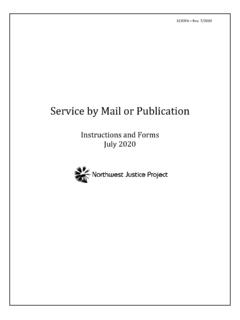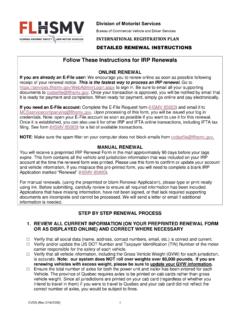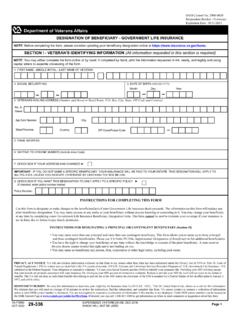Transcription of HOW TO WRITE A DECLARATION - WashingtonLawHelp.org
1 3917EN Rev. 5/2016 1 How to WRITE a DECLARATION in a Family Law Case What is a DECLARATION ? It is a written statement, sworn to be the truth under penalty of perjury by someone with direct knowledge about the issues in a court case. What is it for? You usually use Declarations when filing or responding to motions in court. A DECLARATION s information can help the judge1 decide on the motion. At a hearing on a motion, the parties do not get much time to speak. You also usually cannot testify about facts in the case. Anything the judge needs to know to make a decision at the hearing should be in a DECLARATION . If the judge has appointed a guardian ad litem (GAL), the GAL will often use the declarations: to understand the issues to help determine what is in the child's best interests to understand whether a child has been harmed or would be harmed by living with a parent The parties usually file the originals of signed declarations with the court and serve copies on other parties with the motion, or the response or reply to the motion.
2 What is in this packet? the general DECLARATION form you must use three sealed cover sheets instructions and suggestions for these forms, including how and when to use a sealed cover sheet 1 Court commissioners, not judges, make many decisions in family law cases. Court commissioners are like judges, but only make decisions relating to a particular subject matter. Many counties have family law commissioners who decide only family law cases. In this publication, judge means judge OR commissioner. 3917EN Rev. 5/2016 2 Who should not use the DECLARATION form in this packet? If you are getting ready for trial, your witnesses will usually must appear in person, not by DECLARATION . Judges usually do not admit declarations as evidence at a A few counties might allow or require oral testimony at motions hearings.
3 Most decide motions based on declarations. Check your local court rules. Some motions have special DECLARATION forms. They are not in this packet. If you need a DECLARATION for a particular motion, you may need a special form used just for that motion. Example: A DECLARATION : Personal Service Could Not be Made in Washington form. Our website, , has a list of family law packets for many different motions. Each packet has the state-wide court forms for that motion. Court forms are also available on the court s website: By presenting a DECLARATION from a witness, you may be giving up the right to keep confidential other information that witness may have about you or the child. Who should WRITE the DECLARATION ? If you are a party (petitioner or respondent), you may need to WRITE your own DECLARATION at different pre-trial stages of the case,3 to: tell your side of the story explain your requests give needed information respond to someone else s DECLARATION You can also ask other people who have directly seen, heard, or otherwise witnessed important events to WRITE declarations explaining what they know.
4 Some examples of people to ask: teachers doctors relatives counselors friends 2 One exception: child support modification cases often have trial by affidavit ( DECLARATION ) instead of in-person testimony. 3 Some motions require special DECLARATION forms not in this packet. 3917EN Rev. 5/2016 3 scout leaders coaches clergy cops or other law enforcement officers neighbors Generally, you do not need more than one witness to give the same information, especially if everyone agrees the info is true. If several witnesses would say the same things, choose just one or two to WRITE a DECLARATION . Generally, the judge gives more weight to a neutral person or professional than someone obviously supporting only one side of the case.
5 The more specific information someone has about the parties and/or child, the better for your case. Teachers, counselors, and/or other such professionals may need a signed release of information form before writing the DECLARATION . Some courts limit the number of declarations they will accept or the total number of pages you can file. Check your local court rules. What is an exhibit? It is a document -- written proof attached to a DECLARATION that helps prove what the DECLARATION says. Examples: copies of bills school records medical or treatment records police records You should call the papers you attach to your DECLARATION Exhibits and either number (1, 2, 3) or letter (A, B, C) them. C ertain types of exhibits need a sealed records cover sheet.
6 We explain more below. Some counties say attachment instead of exhibit. Your county may have its own rules for using exhibits or attachments. General instructions for the forms in this packet: The main family law packets at have more complete General Instructions. The info below is shorter. It has info you will probably need when writing declarations in a case that has already been filed. 3917EN Rev. 5/2016 4 Format: The p leadings (legal forms) you file with the court must follow court rules about size and margins (GR 14(a)). You must use regular size (8 x 11 ) white paper. You must use only one side of the paper. The first page of each paper you file must have a three-inch margin (three inches of space) at the top. The other margins (left, right and bottom, and the top from the second page on) must be at least one-inch wide.
7 Use black or dark blue ink. If your forms do not follow these rules, the court clerk may refuse to file them or may make you pay a fine. The caption. The caption has the case name and number, the court s name, and the court paper s title. It appears at the top of the first page of every pleading. Name of the court. Put the name of the county where the case is filed in the blank where it says "Superior Court of Washington County of ." Case name. Fill out the names the same as they are on the Petition. Case number. Put the case number from the Petition near the top on the right-hand section of the first page of every form. Identifying Information. The next two boxes explain these court rules protecting your privacy: GR 15, GR22 and GR 31.
8 Use this info and the instructions for each form to help you decide if you need a sealed cover sheet. Box #1 Almost all pleadings, orders and other papers filed with the court are available to the public, and may be available online. Things You Should Not Put in Most Court Papers: Home Address (where you live) and Phone Number: You do not have to put these in court papers. You do need to give an address where you can get mail from the court. You should also give the court a phone number where they can reach you. Social Security/Driver s License, ID Numbers of Adults and Children: You do not have to put these in court papers. I f you do, put only the last four digits, not the whole number. Dates of Birth of Children: Do not put them in court papers.
9 Bank Account, Credit Card Numbers: Put the bank name, type of account (savings, checking, and so on), and only the last four digits of the account number. 3917EN Rev. 5/2016 5 Box #2: PRIVATE INFORMATION YOU SHOULD FILE WITH SEALED COVER SHEETS: If you use a sealed cover sheet, the other party and the court can still see this information. It does not go in the public file. Financial Information: You should attach pay stubs, checks, loan applications, tax returns, credit card statements, check registers, W-2 forms, bank statements, or retirement plan orders to a Sealed Financial Source Documents form. Medical or Mental Health Records or Information: You should attach papers that have health or mental health information (information about past, present, or future physical or mental health of a person, including insurance or payment records) to a Sealed Personal Health Care Records form.
10 Confidential Reports: Reports such as Parenting Evaluations, CPS Reports, Domestic Violence Assessments, and Guardian ad Litem Reports that are for court use must have two sections, public and private. You should attach the private section to a Sealed Confidential Reports Cover Sheet. Retirement Plan Orders: Certain retirement information belongs in the public file. Retirement Plan Orders do not. Use the Sealed Financial Source Documents Cover Sheet for the Retirement Plan Order. Read GR 22 or see a lawyer if this affects your case. Other Kinds of Confidential or Embarrassing Information Not Mentioned Above. If the paper you want confidential is not in the above list, you may have to ask court permission to seal that paper or part of it under General Rule (GR) 15.












